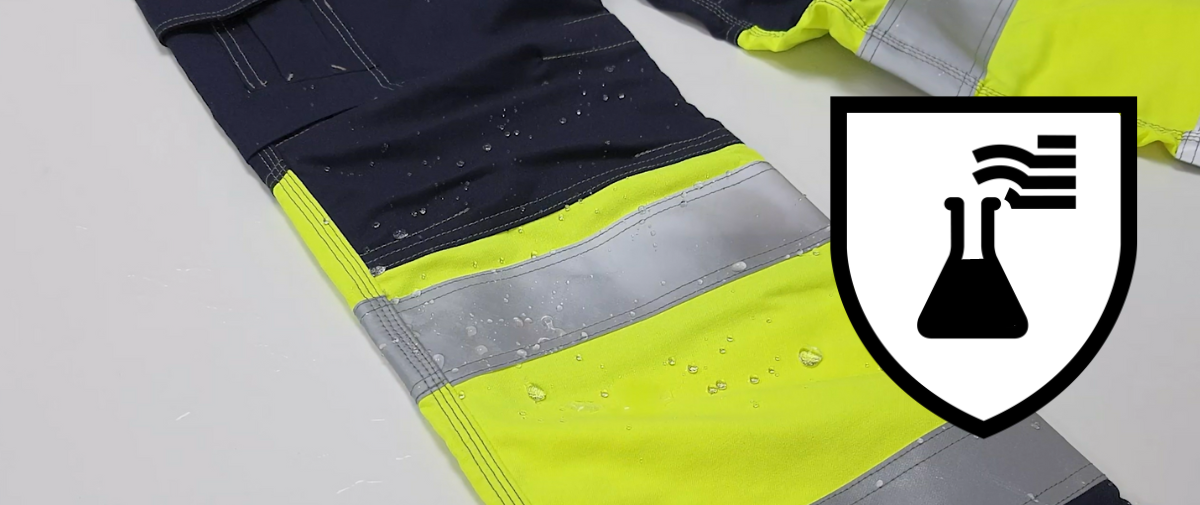
EN 13034
Protective Clothing against Liquid Chemicals – Limited Protective Performance
Personal Protective Equipment within this category must demonstrate its suitability to protect where there is a risk of potential exposure to a light mist spray, liquid aerosols, or low volume splashes against which a complete liquid permeation barrier (at the molecular level) is not required.
Under the EN 13034 standard, the fabric is tested for protection against four liquid chemicals:
- Sulphuric acid (dissolved in water with a concentration of 30%)
- Sodium Hydroxide (dissolved in water with a concentration of 10%)
- O-Xylene (100% undiluted)
- Butanol (100% undiluted)
These four chemicals represent common chemicals often found and used in the Industrial workplace.
About the EN 13034 Testing Process
EN13034 testing is carried out at 20°C ± 2 and 65% ± 5% and then there are then two results from the test. Firstly, how much chemical liquid is repelled by the fabric, and secondly, the percentage of the liquid that the fabric will let penetrate. The results are taken 60secs after the start of the test and then allow the fabrics to be placed into either Class 1, 2, or 3 (the highest being 3) depending on the results and according to the following tables:
| Class | Liquid Repellancy |
|---|---|
| 1 | >80% |
| 2 | >90% |
| 3 | >95% |
| Class | Resistance to Penetration |
|---|---|
| 1 | <10% |
| 2 | <5% |
| 3 | <1% |

See above, a video demonstration of the technology that makes this possible. These trousers have a FC Fluorocarbon finish!
Understanding the Limitations of EN 13034
For a fabric to achieve the EN 13034 standard, a performance level of Class 3 for liquid repellency shall be obtained for at least one of the chemicals in the table above, and for resistance to penetration by liquids a performance level of at least 2 shall be obtained for at least one of the chemicals in the table above. Usually, two chemicals pass the requirements, namely sulphuric acid (H2SO4) and sodium hydroxide (NaOH).
Hence the limitations of the EN 13034 standard as there are clearly thousands of other chemicals used in the workplace which could impact a fabric and reach the wearer in different ways. However, if you wish to test an additional chemical that is specific to your workplace, then this is easily achieved for a small additional cost, and the resulting Repellency and Penetration classifications will be provided to you in an official report.
EN 13034 Test data for Diesel and Petrol
Hazchem has undertaken additional testing to EN 13034 for Petrol and Diesel – 2 liquids used daily by our customers. We can share these results with you on request and help you understand further the benefits HAZTEC® Workwear which is certified to EN 13034 can offer.
Washing EN 13034 Workwear (Woven – not Non-Woven Type 5/6 Disposables)
When the fabric is new, the EN 13034 treatment is also new and able to protect at its maximum level. Washing cycles however will reduce the performance of the treatment and if continued protection is required, the garments should be retreated. Whilst this can be performed in a domestic washing machine, the drying cycle is also equally important to reapply the treatment onto the fabric. This process of retreatment is best done by a professional laundry, and we recommend you discuss this with your provider. Please find information about PHS HERE.
You can also read more about washing your HAZTEC® Flame Resistant Workwear in our Washing Guide HERE.
Understanding Type 6 versus Type PB6 under EN 13034
You will also notice that some garments certified to EN 13034 are certified to Type 6 and some to Type PB6. For a garment to pass Type 6, 3 full suits (or coveralls) are tested in a laboratory on a mannequin. This test is called the Light Spray Test (or Mist Test), and it determines the level of inward leakage (penetration) through the suit material and seams. To meet the requirements of the EN13034 standard the inward leakage must be less than or equal to 3 times the total calibrated stain area on the undergarment.
PB stands for Partial Body protection. Where a Trouser and Jacket combination for example is available, to match with a complete suit/coverall that has been tested under the Spray (Mist) Test, then you will see these garments marked as Type PB [6]. When worn in conjunction with each other, the protecting properties of the ensemble are deemed to be the same as the suit/coverall.
Abrasion, Tear, Tensile, Flexcrack, Puncture and Seams are tested within EN13034 Part 4, but are tested in accordance with EN14325 – these are mandatory parts of the EN13034 standard.
Other testing requirements under EN 13034
There are other tests performed under the EN 13034 standard and these include Abrasion Resistance, Seam Strength, Tear Strength, and Puncture Resistant tests. All these tests ensure that the garment will provide sufficient protection to your team with wearing these garments and for any of these tests, the minimum requirement must also be achieved.
Useful Links: